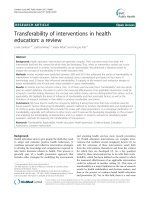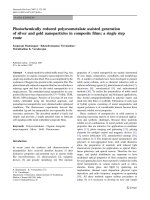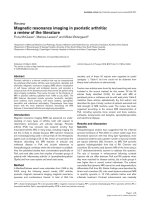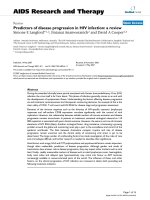Application of nanoparticles in applied science: A review
Bạn đang xem bản rút gọn của tài liệu. Xem và tải ngay bản đầy đủ của tài liệu tại đây (113.42 KB, 8 trang )
Int.J.Curr.Microbiol.App.Sci (2019) 8(10): 2318-2325
International Journal of Current Microbiology and Applied Sciences
ISSN: 2319-7706 Volume 8 Number 10 (2019)
Journal homepage:
Review Article
/>
Application of Nanoparticles in Applied Science: A Review
Anand Pal1, Sarita Rani2*, Jagdish Parshad3, Tejpal4 and Satpal5
1
Department of Senior Secondary Education, 2Department of Agronomy,
3
Department of Microbiology, 4Department of Zoology, 5Department of Forage Section,
Genetics and Plant Breeding, CCS Haryana Agricultural University,
Hisar, Haryana, India-125004
*Corresponding author
ABSTRACT
Keywords
Nanoparticles,
Nanotechnology,
Agriculture
Article Info
Accepted:
17 September 2019
Available Online:
10 October 2019
Nanoparticles have wide applications in everyday life. As world population
is increasing, it is necessary to use the modern technologies to fulfill needs
of present era. Nanoparticle based technology is one of them and has many
applications in all stages of production, processing, storing, packaging
transports, precision farming techniques, in almost all consumer products,
enhancing the ability of plants to absorb nutrients, more efficient and
targeted use of inputs, disease detection and control diseases, withstand
environmental pressures, in all the fields like cosmetics, paint industry, in
medicine, in medical treatment, in food industry, horticulture, agriculture,
materials for construction, environmental safety, energy source and in
energy conservation. We can make new devices at low cost and more
useful to society. Nanoparticle based technology has entered in everyday
life and made the life very easy.
Introduction
Nanoparticles are the particles having size in
between 1to 100 nanometers and are classified
into compact materials and nanodispersions.
The compact material includes nanostructured
materials i.e., materials isotropic in the
macroscopic composition and consisting of
contacting nanometer-sized units as repeating
structural elements (Gusev and Rampel,
2004). The particles with small size in the
range from a few to several tens of nanometers
are called quasi zero-dimensional mesoscopic
systems, quantum dots, quantized or Qparticles, (Khairutdinov et al., 1996).
Nanoparticles can differ in their basic
properties from other particles from long and
well-known ultra dispersed powders with a
2318
Int.J.Curr.Microbiol.App.Sci (2019) 8(10): 2318-2325
grain size above 0.5 µm. As a rule,
nanoparticles are shaped like spheroids due to
ordered arrangement of atoms (or 2 ions) i.e.
nanocrystallites.
Nanoparticles with discrete electronic energy
levels are referred to as quantum dots or
artificial atoms; used in typical semiconductor
and magnetic materials.
Many magnetic nanoparticles have the same
set of electronic levels and are of great
scientific interest because they represent a
bridge between bulk materials, molecules and
structures at an atomic level.
The term cluster widely used in the chemistry
literature in previous years, is currently used
to designate small nanoparticles with sizes less
than 1 nm. The magnetic molecular clusters
(Magnetic
polynuclear
coordination
compounds) belong to the special type of
magnetic materials with unique magnetic
characteristics, which have the distributions in
sizes and are the fully identical small magnetic
nanoparticles.
Their magnetism is usually described in terms
of exchange-modified paramagnetism (Gubin
2009) and; has wide application in biology,
chemistry, environmental studies, medicine,
and biotechnology and has strong impact on
society. The potential uses of nanoparticles in
the environmental sector include waste water
management, contaminated soil treatment,
sensors and energy storage.
Types and classification
Nanomaterials
are
classified
different
categories based up on materials used,
dimensions of electrons movements, origin,
fabrication methods and characteristics. These
are categories into four types i.e. carbon
based, inorganic, organic and composite
nanoparticles. These are discussed below one
by one:
Carbon-based nanoparticles
The nanoparticles which contain carbon, are
found in spheres, hollow tubes, or ellipsoids. It
includes Fullerenes (C60), carbon nanotubes
(CNTs), carbon nanofibers, carbon black,
graphene (Gr), and carbon onions. These are
produced by Laser ablation, arc discharge and
chemical vapour deposition (CVD) methods in
which carbon-based materials (except carbon
black) are used.
Inorganic-based nanoparticles
These are made up of metal and metal oxides
and are synthesized from metals like Ag, Au,
Si, metal-oxides viz. ZnO and TiO2. These are
used in semiconductors and ceramics.
Organic-based nanoparticles
These are made up mostly from organic
substances or compounds, excluding carbonbased or inorganic-based nanomaterials. The
utilization of properties of non-covalent
interactions for the self-assembly and; design
of molecules helps to transform the organic
nanomaterials into many desired structures
such as micelles, dendrimers, liposomes and
polymer of nanoparticles.
Composite-based nanomaterials
These
nanomaterials
are
multiphase
nanoparticles and nanostructured materials
with one phase on the nanoscale dimension
that can either combine one nanoparticles with
other one or nanoparticles combined with
larger or with bulk-type materials lead to form
hybrid nanofibers or more complicated
structures like metal-organic frameworks.
The composites may be any combinations of
carbon-based, metal-based, or organic-based
nanomaterials with any form of metal,
ceramic, or polymer bulk materials.
2319
Int.J.Curr.Microbiol.App.Sci (2019) 8(10): 2318-2325
Classification of nanomaterials based on
their dimensions
Nanomaterials can also be classified on the
basis of electron movement along with the
dimensions i.e. electrons in zero dimension
nanomaterials are trapped in a dimensionless
space
whereas
as
one
dimension
nanomaterials have electrons with moving
ability along the x-axis. Similarly, two and
three
dimension
nanomaterials
have
movement of electron along the x–y-axis,
and x, y, z-axis, respectively.
Classification of nanomaterials on the basis
of origin
On the basis of their origin of materials used
in the preparation of nanomaterials,
nanoparticles are classified as natural or
synthetic nanoparticles.
Natural nanomaterials
These are produced in nature either by
biological species or through anthropogenic
activities. These are produced by the
substances available in the natural resources
present on earth.
Synthetic nanomaterials
These nanomaterialsare produced by physical,
chemical, biological or hybrid methods using
mechanical grinding, engine exhaust and
smoke. These are also called as engineered
nanomaterials.
Applications of nanoparticles in different
fields
In Medicine
In recent technique nanoparticles are used to
transport drugs at specific target and to
particular cells. They can be used to supply
heat, light and other substance in particular
area that helpful in direct treatment of
diseased cell. This technique can be very
helpful in treatment of cancer cells (P Bradley,
2011). The use of polymeric micelle
nanoparticles to deliver drugs to tumours: The
use of polymer coated iron oxide nanoparticles
to break up clusters of bacteria, possibly
allowing more effective treatment of chronic
bacterial infections. The surface change of
protein filled nanoparticles has been shown to
affect the ability of the nanoparticle to
stimulate
immune
responses.
These
nanoparticles may be used in inhalable
vaccines. The cerium oxide nanoparticles act
as an antioxidant to remove oxygen free
radicals that are present in a patient's
bloodstream following a traumatic injury. The
nanoparticles absorb the oxygen free radicals
and then release the oxygen in a less
dangerous state, freeing up the nanoparticle to
absorb more free radicals. Researchers are
developing ways to use carbon nanoparticles
called nanodiamonds in medical applications.
For example, Nanodiamonds with protein
molecules attached can be used to increase
bone growth around dental or joint implants.
In agriculture and horticulture
World agriculture is facing the major
challenges like changing climate, sustainable
use of natural resources, urbanization,
environmental hazards like runoff and
accumulation of herbicides, pesticides and
fertilizers etc. These issues are further
intensified by an increase in food demand that
will be needed to feed an estimated population
of 6–9 billion by 2050 (Chen and Yada, 2011).
Many technologies have been developed by
researchers that have the potential to enhance
farm productivity and also decrease the
environmental and resource costs which are
related with agricultural production (Ditta,
2012). Numerous reports have revealed the
use of nano-particles in agriculture such as
2320
Int.J.Curr.Microbiol.App.Sci (2019) 8(10): 2318-2325
nano scale carriers for efficient delivery of
herbicides, pesticides, plant growth regulators
and fertilizers etc., nano encapsulation for
reduced use of pesticides. Similarly, use of
nano herbicides in an eco-friendly way,
without leaving toxic residues in environment,
is a better approach for eradication of weeds
with reduced amount of herbicides.
Nano-particles can also be used as
disinfectants in packaging and engineering of
food to increase the shelf life of food products
(Ali et al., 2014).Nanotechnology has
potential to facilitate the future stage of
precision farming techniques and this will
enhance agricultural potential in getting higher
yields in eco-friendly way even in present day
challenging environment (Sugunan and Dutta,
2010).
In manufacturing and materials
Ceramic silicon carbide nanoparticles
dispersed in magnesium produce a strong,
lightweight material. A synthetic skin that
may be used in prosthetics has been
demonstrated with both self-healing capability
and the ability to sense pressure. The material
is a composite of nickel nanoparticles and a
polymer. If the material is held together after a
cut it seals together in about 30 minutes giving
it a self-healing ability.
Also the electrical resistance of the material
changes with pressure, giving it sense ability
like touch. Silicate nanoparticles can be used
to provide a barrier to gases (for example
oxygen), or moisture in a plastic film used for
packaging. This could slow down the process
of spoiling or drying out in food. Zinc oxide
nanoparticles can be dispersed in industrial
coatings to protect wood, plastic and textiles
from exposure to UV rays. Silicon dioxide
crystalline nanoparticles can be used to fill
gaps between carbon fibres, thereby
strengthening
tennis
racquets.
Silver
nanoparticles in fabric are used to kill bacteria,
making clothing odour-resistant.
In energy and electronics
Researchers have used nanoparticles called
nanotetrapods studded with nanoparticles of
carbon to develop low cost electrodes for fuel
cells. This electrode may be able to replace the
expensive platinum needed for fuel cell
catalysts. Researchers at Georgia Tech, the
University of Tokyo and Microsoft Research
have developed a method to print prototype
circuit boards using standard inkjet printers.
Silver nanoparticle ink was used to form the
conductive lines needed in circuit boards.
Combining gold nanoparticles with organic
molecules creates a transistor known as a
NOMFET (Nanoparticle Organic Memory
Field-Effect Transistor). This transistor is
unusual in that it can function in a way similar
to synapses in the nervous system. A catalyst
using platinum-cobalt nanoparticles is being
developed for fuel cells that produce twelve
times more catalytic activity than pure
platinum. In order to achieve this
performance, researchers anneal nanoparticles
to form them into a crystalline lattice,
reducing the spacing between platinum atoms
on the surface and increasing their reactivity.
Researchers have demonstrated that sunlight,
concentrated on nanoparticles, can produce
steam with high energy efficiency. The "solar
steam device" is intended to be used in areas
of developing countries without electricity for
applications such as purifying water or
disinfecting dental instruments.
A lead free solders reliable enough for space
missions and other high stress environments
using
copper
nanoparticles.
Silicon
nanoparticles coating anodes of lithium-ion
batteries can increase battery power and
reduce
recharge
time.
Semiconductor
nanoparticles are being applied in a low
temperature printing process that enables the
2321
Int.J.Curr.Microbiol.App.Sci (2019) 8(10): 2318-2325
manufacture of low cost solar cells. A layer of
closely spaced palladium nanoparticles is
being used in a hydrogen sensor. When
hydrogen is absorbed, the palladium
nanoparticles swell, causing shorts between
nanoparticles. These shorts lower the
resistance of the palladium layer.
In electro deposition
Nanostructured materials can also be produced
by electro deposition. These films are
mechanically strong, uniform and strong.
Substantial progress has been made in
nanostructured coatings applied either by
DVD or CVD. Many other non-conventional
processes such as hypersonic plasma particle
deposition (HPPD) have been used to
synthesize and deposit nanoparticles. The
significant potential of nanomaterial synthesis
and their applications is virtually unexplored.
They offer numerous challenges to overcome.
Understanding more of synthesis would help
in designing better materials. It has been
shown
that
certain
properties
of
nanostructured deposits such as hardness,
wear resistance and electrical resistivity are
strongly affected by grain size. A combination
of increased hardness and wear resistance
results in a superior coating performance.
In semiconductor physics
By using nanoparticles we can decrease power
consumption and Size of semiconductor
devices. Storage capacity of memory chip can
also be increased. We can improve quality of
integrated circuit.
In Domestic product
Nanoparticles can be used in many domestic
products in every day used by using
nanoparticles in cosmetic products we can
supply vitamins deep into the skin. By using
carbon nanoparticles we can make fire
resistant furniture. Quality and storage of
lithium ion battery can be much improved
with the help of nanoparticles. By using some
nano composite plastic we can make scratch
resistant body of vehicles and other
appliances. We can make light weight,
rustproof and strong long life of body of
appliance. Nan crystalline coated silver can be
used to kill the bacteria in very short time.
Chemical-Free [sic] Sunscreen SPF 15 (Burts
BeesR,Inc.) contains nano-sized particles of
titanium dioxide as the active ingredient. Food
Supplements and food storage: Mesozinc
nutritional supplement containing 30 parts per
million(ppm) zinc nanoparticles are used to
store food.
In food storage
Food storage containers are infused with silver
nanoparticles as they are antibacterial agent so
protect from bacteria. Deodorizer--"silver
nano poly system" acts as an antibacterial and
deodorizer. Appliances: Samsung Washing
Machine)-Silver nano technology "can be used
to sterilizes the clothes. Vacuum Cleaner
nano-silver coated cyclone canister removes
bacteria. Air Conditioner contains silver nano
filter and silver nanoevaporator to purify the
air. Clothing: Sport Anklet Socks silver
Active-- treated with nanoparticles of silver
(typically 25 nm) as bactericide and fungicide.
Coatings: Pilkington Active Self Cleaning
Glass-glass coating that works with ultraviolet
(UV) light and rain to keep glass free from
organic dirt. UltimaR Photo Paper (Eastman
KodakR Company) nine-layer composition
incorporates ceramic nanoparticles to resist
the effects of heat, humidity, light and ozone
gas. Electronics and computers: Invisicon
(EikosR) Invisicon ink used to create
transparent
conductive
coatings
and
manufacture printed circuits on transparent
plastic
films;
Microprocessor
chip
manufactured by IBM using IBM's 90
2322
Int.J.Curr.Microbiol.App.Sci (2019) 8(10): 2318-2325
nanometer Silicon on Insulator (SOI)
technology to reduce heat and improve
performance.
In production of nanoadsorbent
Pharmaceuticals city wastes are the main
pollutants in drinking water. Nanoparticles can
be used to purify the drinking water in mainly
three types as adsorbent, as catalyst and as
membrane to remove pollutants from water.
Adsorption can remove organic and inorganic
pollutants from waste water. Nanoadsorbant
provide large area and large number of active
sites compared to normal adsorbent. So
nanoparticles are very helpful in wastewater
treatment. nanoadsorbent may be magnetic,
non magnetic and carbon based and may be
metal oxide and zeolites. Nanoparticles used
as adsorbent should be no harmful and
moreadsorption.
In Water treatment
In water treatment, removal of nonbiodegradable organic pollutants is not
possible by conventional treatment methods.
So, to find a new, efficient and eco-friendly
technology that can remove these pollutants
with less use of energy and chemicals is the
need of present day.
Therefore, researchers have concentrated on
some advanced alternative methods of
oxidation that have capability of oxidizing and
mineralizing
the
organic
chemicals
(Comninellis et al., 2008).
To improve the biodegradability of organic
contaminants and to remove the recent
microbial pathogens, Photo catalysis has been
considered as best method. Photocatalytic
oxidation consists of a class of reactions that
use the catalyst activated by solar or other
forms of energy (Bahnemann 2004)
In production of Nanomembrane
Nanomembrane can be used in waste water
treatment because they have low cost and low
power consumption. Rao (2014) found that for
improving the water quality of desired value,
the pressure driven treatment of wastewater
has been proved best in this technique.
In Remediation
No chemical addition is required in water
remediation because of its more separation
efficiency and easy operation. It does not lead
to secondary pollution as well as no
regeneration of spent media is required
(Balamurugan et al., 2011). The performance
of the membrane system is dependent on the
membrane material, which depend on
membrane selectivity and permeability.
The common membrane materials applied for
water treatment are polymers, cellulose
acetate, poly acrylonitrile, and polyamide
(Yang et al., 2009). Based on the pore size and
filtration application, the membrane process
can be classified as microfiltration for
suspended solids, Protozoa, and bacteria
removal, ultrafiltration for virus and colloid
removal, nanofiltration for hardness, heavy
metals, and dissolved0organic matter removal.
In various energy sources
Nano particles have great potential to increase
energy efficiency, energy conservation,
storage usage and saving. Nanoparticles can
used to increase the efficiency of solar cell and
fuel cell. Solar cell or photovoltaic cell is the
device that converts solar energy in to
electrical energy. They are made of
semiconductor silicon or germanium. They
have efficiency about 14% and high cost. The
first generation solar cells are made of silicon
wafer having performance 15% to 20 %. The
second generation solar cells are made on the
2323
Int.J.Curr.Microbiol.App.Sci (2019) 8(10): 2318-2325
basis of thin film coating using amorphous
silicon and cadmium telluride having much
less cost while third generation cells are based
on nanoparticles and nano-porous materials
but they are in research stage.
In artificial photosynthesis
Artificial photosynthesis process is important
means of renewable energy production with
use of fossil fuels and carbon emission.
Nanotechnology helps in this process
In Energy storage batteries
In almost all the electronics devices in small
power tools and electric vehicles, lithium ion
batteries are used. For more safety anode may
be used made of nanowires or nanorod
materials. In latest discoveries ultra high
capacity anode materials such as Si nanowires,
Ge nanowires and tin nanoparticles coated
with carbon embedded with grapheme has
more cycle performance and high conductivity
In production of Super capacitors
Super capacitor is ultra capacitor they can
store more energy electrostaticaly by
polarizing the electrolyte. The performance of
super capacitor is between normal capacitor
and batteries.
In carbon capture
Fossil fuels are used by most of the industries
through combustion and release carbon
dioxide in atmosphere by using nanoparticles
amine based absorption. The adsorbent like
activated carbon and zeolite being high
thermal and chemical stability can be used as
carbon dioxide capture.
In environmental sensing
Nanoparticles can be used to build low cost
high sensitive detection system for monitoring
air and water quality. These nanoparticles
based sensor have ability to detect toxins,
heavy metals and organic pollutants at very
low concentration.
In Sensors for heavy metal ion detection
Heavy metals such as Cd, lead, Hg, As, are
released in industrial waste they are highly
toxic even at very small levels they are threat
to human beings and all living beings the use
of
nanoparticles
have
improve
the
performance of sensor and wide range of
detection principle like optical, electrical, ion
exchange, semiconductor metal oxide
conductive polymers.
In optical sensing
The most remarkable property of super
capacitor is high power density excellent
reversibility quick operation and long life.
Nanoparticles are used in optical sensing this
include fluorescent, colorimetric, surface
Plasmon resonance and surface enhanced
Raman scattering sensors.
In Pollution control
In electro chemical sensing
Nanoparticles plays important role in
decreasing pollution by using raw materials.
Some nanowires of potassium manganese
oxide were recently observed for cleaning up
oil spills and other organic pollutants.TiO2 can
be used to breakdown of nitrous oxide and
other pollutants into less harmful substances.
In addition to heavy metal ion detection single
walled nanotubes were used to develop sensor
for sensitive detection of microcystin - LR
similarly other sensors for bacterial detection
include
mannoseen
capsulated
gold
nanoparticles for the detection of Escherichia
coli and detection of cholera toxin.
2324
Int.J.Curr.Microbiol.App.Sci (2019) 8(10): 2318-2325
Hence it is clear that nanoparticles are widely
used in almost all the fields. The use of
nanoparticles can make major change in future
life; make it easy at low cost but possible
environmental, social, and ethical implication
should be considered such as testing of
toxicity of nanoparticles, safety design of
nanomaterials,
ecological
impact
of
nanoparticles. Therefore risk of their use in the
environment and possible bad effects on living
beings needs to be checked. The worse
activities of human are disrupting the
ecosystem balance by filling the environment
with large amounts of hazardous toxicants that
pollute the atmosphere especially, soil and
water and consequently threaten health of
human being and wise and precise use of
nanoparticles can help in making balance in
ecosystem with lots of other benefits like
reducing cost, ease of working etc.
References
Ali M.A., Rehman I, Iqbal A, Din S, Rao AQ,
Latif A, Samiullah TR, Azam S,
Husnain T. (2014). Nanotechnology, a
new frontier in Agriculture. Adv. life
sci., 1(3), pp. 129-138.
Bahnemann (2004) https://www. research
gate.net
Balamurugan, A., R. Jayanthi, P. Nepolean.
(2011)
Bradley, P. (2011) Everyday Applications of
nanotechnology. />cle-2630-every day- applications-of
nanotechnology.html, Retrieved march
2014.
Chen H. and Yada R. (2011) Trends Food Sci.
Technol. 22: 585
Christos Comninellis (2008) https://online
library.wiley.com.
Ditta, A. (2012)
How helpful is
nanotechnology
in
agriculture?
Advances in Natural Sciences:
Nanoscience and Nanotechnology
3(3): 033002.
Gusev, A.I. and Rempel, A.A., (2004).
Nanokristallicheskie
materialy
(Nanocrystalline Materials), https://
link.springer.com.
Khairutdinov, R.F. (1996), Chemistry of
Semiconductor Nanoparticles, https://
link.springer.com.
Rao,
L.N.
(2014)
Nanotechnological
methodology
for
treatment
of
wastewater. Int. J. Chem. Tech. Res., 6
(4), p. 2529
Sugunan A. and Dutta J. (2010). Pollution
treatment, remediation and sensing.
Nanotechnology.
/>/10.1002/9783527628155.nanotech013
Yu Yang, Stephon, J. Read, Lynnc Miller.
(2009)
How to cite this article:
Anand Pal, Sarita Rani, Jagdish Parshad, Tejpal and Satpal. 2019. Application of Nanoparticles
in Applied Science: A review. Int.J.Curr.Microbiol.App.Sci. 8(10): 2318-2325.
doi: />
2325









